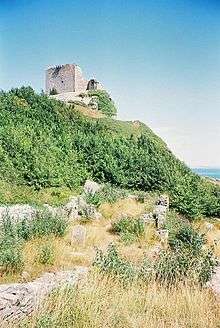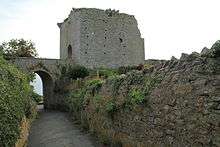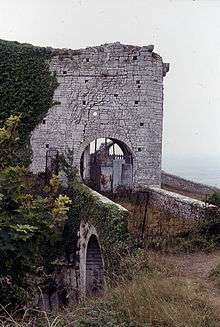Rufus Castle

Rufus Castle, also known as Bow and Arrow Castle, is a ruined blockhouse overlooking Church Ope Cove on Portland, England. The castle dates from the late 15th century, possibly on the site of an earlier building (with origins dating from 1142) - making it Portland's oldest castle. Built on a pinnacle of rock, some of the original structure has been lost to erosion and collapse over the years.
The remaining castle appears to have been the keep of a stronghold, the foundation of which was much above the top of the church tower of St. Andrews which lay in the valley below. The pentagonal tower of the castle has late Medieval gunholes, but rests uncomfortably on an earlier foundation to the north and stepped plinth to the west which may have been a 12th-century keep.[1][2] Remains include parts of the keep, sections of wall with gun ports and a 19th-century round-arched bridge across Church Ope Road.
The castle, including its bridge, has been a Grade I listed building since January 1951. It is one of three buildings on Portland to be Grade I Listed.[3] In addition to this, the castle has become a scheduled monument under the Ancient Monuments and Archaeological Areas Act 1979.[4]
Rufus Castle looks out over the Shambles sandbank, approximately three miles out to sea, one of the most feared navigational hazards in the area.
There is no public access to the castle as it is privately owned, though it can be seen well from public footpaths along the coast.
History
In ancient times for defence against attack, taxes were raised on the island to construct Portland's first castle. Rufus Castle was reportedly built for William II, although the structure seen standing in ruins today is not of that date.[5] In 1142, Robert, Earl of Gloucester, had captured the castle from King Stephen on behalf of Empress Maud. It had additional fortifications added in 1238 by Richard de Clare who owned it at that time.[6] Around 1256, Aylmer de Lusignan obtained a licence to crenellate the 'insulam de Portand' and Robert, Earl of Gloucester, was granted a similar licence just 14 months later. It is generally presumed that Rufus castle is the site of any work that may have resulted from these licences and any remains that may date from the period exist only at foundation level, or have been lost to cliff erosion.[1]
The castle was rebuilt in the 15th century between 1432–60, by Richard, Duke of York, and much of what remains today dates from this time.[7] The politician and writer John Penn built his Gothic Revival mansion overlooking Church Ope Cove, between 1797 and 1800. Penn's new estate encompassed both the ruins of Rufus Castle and that of the former parish church of St Andrews. At this time Penn made alterations to Rufus Castle to transform it into a picturesque folly, he erected a bridge over the lane leading to Church Ope and formed two new large openings in the walls of the castle, with a rounded arch to the West Elevation and Tudor pointed arch to the South which replaced the original door to the structure .[8] In 1989, the castle's seaward arch collapsed and saw other serious damage around that time. By the end of the century English Heritage had proposed to do a restoration to save the castle.[9]
Rufus Castle was sketched by English landscape artist J. M. W. Turner.[10] It also featured as 'Red King's Castle' in Thomas Hardy's novel, "The Well-Beloved", which was set on Portland. Hardy's name for the castle derived from William II, also known as William the Red, for whom the castle is thought to be built.

Extensive restoration and consolidation work was carried out to Rufus Castle in 2010-2012 on behalf of English Heritage, under their scheme of repair and urgent works.[11] The castle had been listed on the Heritage at Risk Register in 2010.[12] Circa mid-2008, the castle was listed as being ruinous and in need of conservation repair and consolidation.[13][14]
Work began in 2010 by historic building and church architect Russ Palmer of Honiton, Devon. With the aid of the English Heritage grant, the project firstly involved investigation of the condition of the castle and the implementation of the first stage of recommended repairs. Extensive repairs were needed, initially to the north walls. Palmer produced a specification for the work and after competitive tenders were obtained, work was carried out by Carrek Ltd between May and October 2010 for a cost of £150,000. The work included the consolidation of the top of the walls and the exposed core at low level, grouting voids between the core and the face of the wall, and repointing. The work was finished by November 2010.[15][16]
Castle design

The castle, constructed in the form of a pentagon, has 7-foot-thick walls to the landward elevations pierced by numerous medieval gun ports, these are often mistakenly referred to as arrow loops, This gave the castle an alternative name; "Bow and Arrow" Castle.[7] It is built with Portland stone, with the walls roughly built of native ashlar.[17] Rufus Castle features walls of roughly squared rubble and no roof. Three of the sides of the castle are considerably longer than the others.[18]
In the north and west walls, at first-floor level, are five embrasures, with circular gunports, to these elevation also are stone corbels in groups of three, these supported a sectional projecting stone parapet. Outside the south gateway are the remains of stone footings. There are no longer any trace remains of the "steppes of stone" that were referred to in Gorse's Antiquities and Coker's Dorset; the steps connected the castle and the old church of St. Andrew.[18]
See also
References
| Wikimedia Commons has media related to Rufus Castle, Dorset. |
- 1 2 "Rufus Castle (The Gatehouse Record)". Gatehouse-gazetteer.info. 10 December 2012. Retrieved 31 December 2012.
- ↑ "Detailed Record". Imagesofengland.org.uk. Retrieved 31 December 2012.
- ↑ Historic England. "Details from listed building database (1280727)". National Heritage List for England. Retrieved 2 October 2015.
- ↑ Historic England. "Details from listed building database (1002698)". National Heritage List for England. Retrieved 2 October 2015.
- ↑ Historic England. "Monument No. 451726". PastScape. Retrieved 2 October 2015.
- ↑ "Pennsylvania Castle and Church Ope, Portland". Geoffkirby.co.uk. 3 April 2003. Retrieved 31 December 2012.
- 1 2 "Rufus Castle, Portland, Dorset, Travel Information". Britainexpress.com. Retrieved 31 December 2012.
- ↑ Morris, Stuart (1985). Portland: An Illustrated History. Dovecote Press. p. 47. ISBN 978-0946159345.
- ↑ Morris, Stuart (1990). Portland Camera. Dovecote Press. pp. Photo 15. ISBN 978-0946159796.
- ↑ http://www.tate.org.uk/art/artworks/turner-bow-and-arrow-or-rufus-castle-portland-d08837
- ↑ "English Heritage | English Heritage". Risk.english-heritage.org.uk. Retrieved 8 October 2013.
- ↑ "Rufus Castle (The Gatehouse Record)". Gatehouse-gazetteer.info. 27 September 2013. Retrieved 8 October 2013.
- ↑ "Historic treasures at risk from neglect (From Dorset Echo)". Dorsetecho.co.uk. 8 July 2008. Retrieved 8 October 2013.
- ↑ http://risk.english-heritage.org.uk/register.aspx?id=46823&rt=1&pn=1&st=a&di=Weymouth+and+Portland&ctype=all&crit=
- ↑ "Rufus Castle, Portland: portfolio of Peter Gunning and Partners, chartered quantity surveyors, construction and cost consultants". Pgandp.co.uk. Retrieved 8 October 2013.
- ↑ "Rufus Castle, Portland » RUSS PALMER - Historic Building and Church Architect". Russpalmerarchitecture.com. Retrieved 8 October 2013.
- ↑ "Portland - Weymouth, Dorset,England - Portland & Portland Bill". Weymouth-dorset.co.uk. Retrieved 31 December 2012.
- 1 2 Portland Urban District Council (c. 1957). Isle of Portland Official Guide. Ed. J. Burrow & Co. Ltd., Publishers - Chelternham and London. p. 21.
Coordinates: 50°32′19″N 2°25′46″W / 50.5385°N 2.4294°W